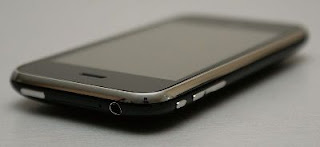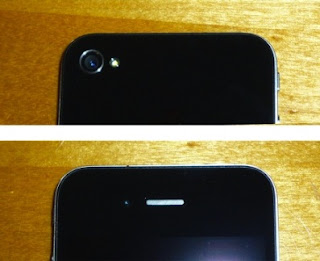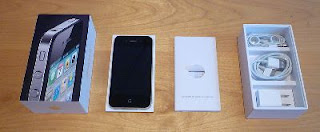The touchscreen is a 9 cm (3.5 in) liquid crystal display with scratch-resistant glass. The capacitive touchscreen is designed for a bare finger, or multiple fingers for multi-touch sensing. The screens on the first three generations of the iPhone have a resolution of 320 x 480 (HVGA) at 163 ppi, while the display on the iPhone 4 has a resolution of 640 x 960 at 326 ppi.
The touch and gesture features of the iPhone are based on technology originally developed by FingerWorks. Most gloves and styluses prevent the necessary electrical conductivity; however, capacitive styli can be used with iPhone's finger-touch screen. The iPhone 3GS also features a fingerprint-resistant oleophobic coating.


The iPhone has a minimal hardware user interface, featuring only four or five buttons, depending on whether the volume control is counted as one button or two. The only physical menu button is situated directly below the display, and is called the "Home button" because it closes the active app and navigates to the home screen of the interface. The home button is denoted not by a house, as on many other similar devices, but a rounded square, reminiscent of the shape of icons on the home screen. A multifunction sleep/wake button is located on the top of the device. It serves as the unit's power button, and also controls phone calls. When a call is received, pressing the sleep/wake button once silences the ringtone, and when pressed twice transfers the call to voicemail. Situated on the left spine are the volume adjustment controls. The iPhone 4 has two separate circular buttons to increase and decrease the volume; all earlier models house two switches under a single plastic panel, known as a rocker switch. Directly above the volume controls is a silence button that mutes all sound when engaged. All buttons except Home were made of plastic on the original iPhone and metal on all later models. The touchscreen furnishes the remainder of the user interface.
The display responds to three sensors. A proximity sensor deactivates the display and touchscreen when the device is brought near the face during a call. This is done to save battery power and to prevent inadvertent inputs from the user's face and ears. An ambient light sensor adjusts the display brightness which in turn saves battery power. A 3-axis accelerometer senses the orientation of the phone and changes the screen accordingly, allowing the user to easily switch between portrait and landscape mode. Photo browsing, web browsing, and music playing support both upright and left or right widescreen orientations. Unlike the iPad, the iPhone does not rotate the screen when turned upside-down, with the Home button above the screen. The 3.0 update added landscape support for still other applications, such as email, and introduced shaking the unit as a form of input. The accelerometer can also be used to control third party apps, notably games. The iPhone 4 also includes a gyroscopic sensor, enhancing its perception of how it is moved.
A software update in January 2008 allowed the first generation iPhone to use cell tower and Wi-Fi network locations trilateration, despite lacking GPS hardware. The iPhone 3G, 3GS and 4 employ A-GPS, and the iPhone 3GS and 4 also have a digital compass.
Audio and output
The bottom of the iPhone sports a speaker (left) and a microphone (right) flanking the dock connector. One loudspeaker is located above the screen as an earpiece, and another is located on the left side of the bottom of the unit, opposite a microphone on the bottom-right. The iPhone 4 includes an additional microphone at the top of the unit for noise cancellation, and switches the placement of the microphone and speaker on the base on the unit—the speaker is on the left. Volume controls are located on the left side of all iPhone models and as a slider in the iPod application.
The 3.5 mm TRRS connector for the headphones is located on the top left corner of the device. The headphone socket on the original iPhone is recessed into the casing, making it incompatible with most headsets without the use of an adapter. Subsequent generations eliminated the issue by using a flush-mounted headphone socket. Cars equipped with an auxiliary jack allow for handsfree use of the iPhone while driving as a substitute for Bluetooth.
While the iPhone is compatible with normal headphones, Apple provides a headset with additional functionality. A multipurpose button near the microphone can be used to play or pause music, skip tracks, and answer or end phone calls without touching the iPhone. A small number of third-party headsets specifically designed for the iPhone also include the microphone and control button. The current headsets also provide volume controls, which are only compatible with more recent models. These features are achieved by a fourth ring in the audio jack that carries this extra information.
The built-in Bluetooth 2.x+EDR supports wireless earpieces and headphones, which requires the HSP profile. Stereo audio was added in the 3.0 update for hardware that supports A2DP. While non-sanctioned third-party solutions exist, the iPhone does not officially support the OBEX file transfer protocol. The lack of these profiles prevents iPhone users from exchanging multimedia files, such as pictures, music and videos, with other bluetooth-enabled cell phones.
Composite or component video at up to 576i and stereo audio can be output from the dock connector using an adapter sold by Apple. iPhone 4 also supports 1024x768 VGA output via a dock adapter. The iPhone did not support voice recording until the 3.0 software update.
The iPhone features an internal rechargeable battery. Like an iPod but unlike most other mobile phones, the battery is not user-replaceable. The iPhone can be charged when connected to a computer for syncing across the included USB to dock connector cable, similar to charging an iPod. Alternatively, a USB to AC adapter (or "wall charger," also included) can be connected to the cable to charge directly from an AC outlet. A number of third party accessories (stereos, car chargers, even solar chargers) are also available.
Apple runs tests on preproduction units to determine battery life. Apple's website says that the battery life "is designed to retain up to 80% of its original capacity after 400 full charge and discharge cycles", which is comparable to iPod batteries. The original iPhone's battery was stated to be capable of providing up to seven hours of video, six hours of web browsing, eight hours of talk time, 24 hours of music or up to 250 hours on standby. The iPhone 3G's battery is stated to be capable of providing up to seven hours of video, six hours of web browsing on Wi-Fi or five on 3G, ten hours of 2G talk time, or five on 3G, 24 hours of music, or 300 hours of standby. Apple claims that the 3GS can last for up to ten hours of video, nine hours of web browsing on Wi-Fi or five on 3G, twelve hours of 2G talk time, or five on 3G, 30 hours of music, or 300 hours of standby.
Battery
The battery life of the iPhone has been criticized by several technology journalists as insufficient and less than Apple's claims. This is also reflected by a J. D. Power and Associates customer satisfaction survey, which gave the "battery aspects" of the iPhone 3G its lowest rating of 2 out of 5 stars.
If the battery malfunctions or dies prematurely, the phone can be returned to Apple and replaced for free while still under warranty. The warranty lasts one year from purchase and can be extended to two years with AppleCare. Though the battery replacement service and its pricing was not made known to buyers until the day the product was launched, it is similar to how Apple (and third parties) replace batteries for iPods. The Foundation for Taxpayer and Consumer Rights, a consumer advocate group, has sent a complaint to Apple and AT&T over the fee that consumers have to pay to have the battery replaced. Since July 2007 third party battery replacement kits have been available at a much lower price than Apple's own battery replacement program. These kits often include a small screwdriver and an instruction leaflet, but as with many newer iPod models the battery in the original iPhone has been soldered in. Therefore a soldering iron is required to install the new battery. The iPhone 3G uses a different battery fitted with a connector that is easier to replace, although replacement by any besides Apple still voids the warranty.

The iPhone and iPhone 3G feature a built-in Fixed focus 2.0 megapixel camera located on the back for still digital photos. It has no optical zoom, flash or autofocus, and does not support video recording, however jailbreaking allows users to do so. Version 2.0 of iPhone OS introduced the capability to embed location data in the pictures, producing geocoded photographs.
The iPhone 3GS has a 3.2 megapixel camera, manufactured by OmniVision, featuring autofocus, auto white balance, and auto macro (up to 10 cm). It is also capable of capturing 640x480 (VGA resolution) video at 30 frames per second, although compared to higher-end CCD based video cameras it does exhibit the rolling shutter effect. The video can then be cropped on the device itself and directly uploaded to YouTube, MobileMe, or other services
The iPhone 4 introduced a 5.0 megapixel camera (2592x1936 pixels), also located on the back, which is equipped with a backside illuminated sensor capable of capturing pictures in low-light conditions, as well as an LED flash capable of staying lit for video recording at 720p resolution, considered high-definition. In addition the iPhone 4 has a second camera on the front capable of VGA photos and SD video recording.
Storage and SIM
The iPhone was initially released with two options for internal storage size: 4 GB or 8 GB. On September 5, 2007, Apple discontinued the 4 GB models. On February 5, 2008, Apple added a 16 GB model. The iPhone 3G was available in 16 GB and 8 GB. The iPhone 3GS came in 16 GB and 32 GB variants and still is available in 8 GB. The iPhone 4 is available in 16 GB and 32 GB variants. All data is stored on the internal flash drive; the iPhone does not support expanded storage through a memory card slot, or the SIM card.
The SIM card sits in a tray, which is inserted into a slot at the top of the device. The SIM tray can be ejected with a paperclip or the "SIM eject tool" (a simple piece of die-cut sheet metal) included with the iPhone 3G and 3GS. In most countries, the iPhone is usually sold with a SIM lock, which prevents the iPhone from being used on a different mobile network. The iPhone 4 features a MicroSIM card that is located in a slot on the right side of the device.
Moisture sensors
The iPhone has moisture sensors to indicate whether water damage has affected a device. The sensors on an iPhone include a small disc which is located in the headphone jack and an area near the dock connector. The sensors are often used by Apple employees to determine whether the device qualifies for a warranty repair or replacement, and if the sensors show that the device has absorbed moisture they may determine that the device is not covered. However, the moisture sensors might be "tripped" through routine use, and if a device is worn while exercising the sweat from an owner may dampen the sensors enough to indicate water damage. On many other mobile phones from different manufacturers, the moisture sensors are located in a protected location, such as beneath the battery behind a battery cover, but the sensors on an iPhone are directly exposed to the environment. This has led to criticism of the placement of the sensors, which may also be affected by steam in a bathroom or other light environmental moisture.


All iPhone models include written documentation, and a dock connector to USB cable. The original and 3G iPhones also came with a cleaning cloth. The original iPhone included stereo headset (earbuds and a microphone) and a plastic dock to hold the unit upright while charging and syncing. The iPhone 3G includes a similar headset plus a SIM eject tool (the original model requires a paperclip). The iPhone 3GS includes the SIM eject tool and a revised headset, which adds volume buttons. The iPhone 3G and 3GS are compatible with the same dock, sold separately, but not the original model's dock. All versions include a USB power adapter, or "wall charger," which allows the iPhone to charge from an AC outlet. The iPhone 3G and iPhone 3GS sold in North America, Japan, Colombia, Ecuador, or Peru include an ultracompact USB power adapter. The iPhone 4 owners get free bumper case to temporarily resolve the antenna problems.
(source on wiki)


























